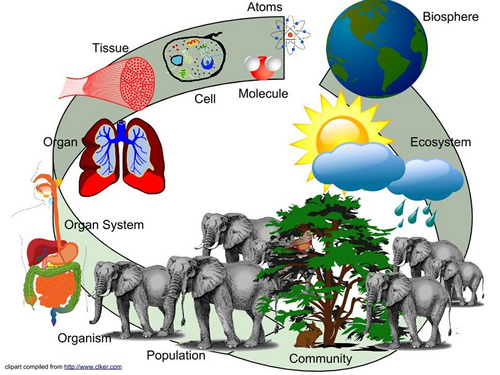Chapter 1.1 - How to Define Life
A. Living Things Are Organized
subatomic particles --> atoms --> molecules -->cells --> tissues --> organs --> organ systems --> organism --> population --> community --> ecosystem --> biosphere
Each level of organization has emergent properties; however, all new properties follow the laws of physics and chemistry.
Example of an emergent property:
B. Living Things Acquire Materials and Energy
1. Maintaining organization and carrying on life requires an outside source of energy (food, sunlight, chemicals)
2. Energy - capacity to do work; it takes work to maintain organization of the cell and organism.
3. Metabolism - all chemical reactions that occur in a cell.
4. Organisms must maintain homeostasisWhat is the relationship between energy and homeostasis?
What happens if homeostasis is not maintained?
C. Living Things Respond
1. Living things interact with the environment in order to find nutrients
or energy.
2. Responses to environment (stimulus) altogether constitute the behavior of an organism.
D. Living Things Reproduce and Develop
1. Reproduction is the ability of an organism to make another organism like itself.
2. Genes are passed from parents to offspring.
E. Living Things Have Adaptations
1. Adaptations - modifications that make an organism suited to its
way of life.
2. Natural selection is process by which species become
modified over time.
3. Evolution is descent with modification.
Adaptations are features (characteristics) that help an organism survive.
What are some examples of adaptations?
- coat coloration in rock pocket mice
- long necks in giraffes
- oppossable thumbs in primates
Recap
1. The process by which a species changes over time is called ____________________
2. The process by which DNA is passed from one generation to the next is ____________________
3. Energy is the capacity to do _________________
4. All the chemical reactions that occur in an organism is ___________________
5. Behavior refers to an organism’s response to a _________________
6. _______________________ can be thought of as unexpected behaviors that stem from interaction between the components of an application and their environment
Case Study - Are Nanobacteria Alive?
1.2 How the Biosphere is Organized
A. Levels of Complexity
1. Biosphere = the zone of air, land, and water where life is found.
2. Population = all members of one species in a
particular area.
3. Community = all of the local interacting populations.
4. Ecosystem = all aspects of a living community
and the physical environment
5. Ecosystems are characterized by chemical cycling and energy flow.
6. Climate is the major determining factor of where ecosystems
occur.

B. The Human Population
1.
Humans modify ecosystems for our own purposes.
2. Some human activity threatens tropical rain forests and coral reefs.
3. Human beings depend on healthy working ecosystems for food, medicines,
and raw materials.
How has the ecosystem of your city been modified?
Are these modifications good or bad?
C. Biodiversity
- consists of the total number of species, their variable
genes, and their ecosystems.
1.3 How Living Things Are Classified
A. Taxonomy: the Discipline of Identifying and Classifying Organisms
B. Categories of Classification: kingdom, phylum, class, order, family, genus and species.
(King Philip Came Over For Great Soup)
In the Kingdoms Plantae and Fungi, the category “phylum” is replaced by “division.”
C. Domains (3) and Kingdoms (6)

Overview of the Kingdoms
| Domain | Kingdom | Cell Nucleus | Number of Cells | Nutrition | Examples |
| Eukarya | |||||
| Bacteria | |||||
| Archaea |
